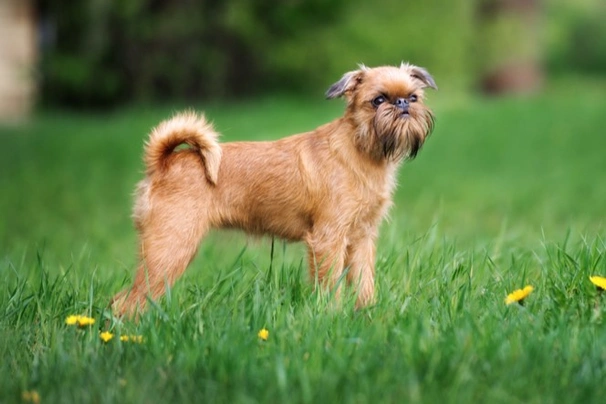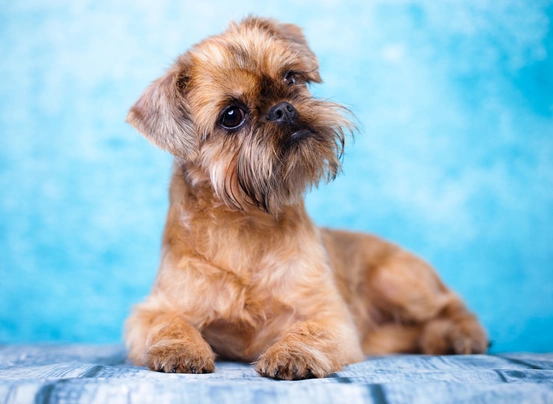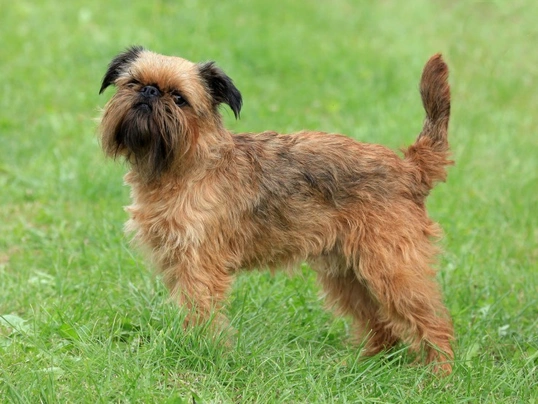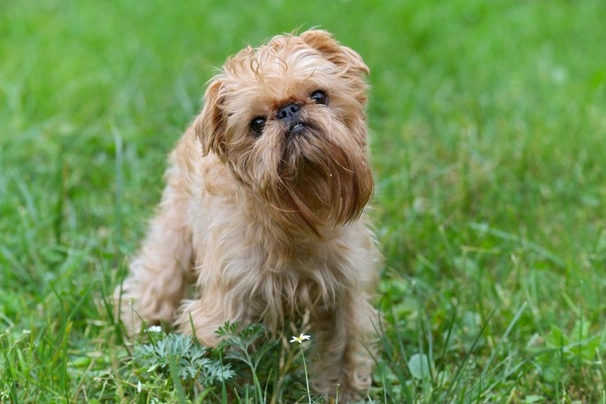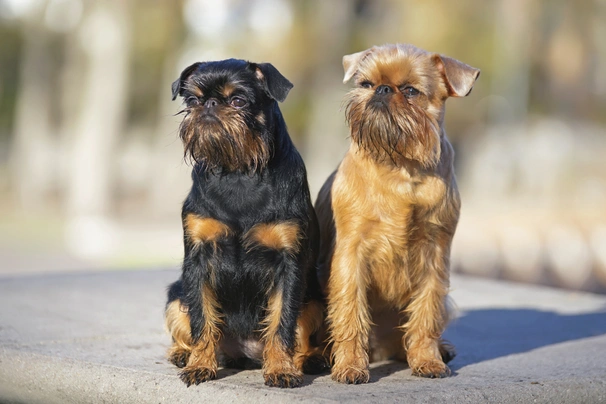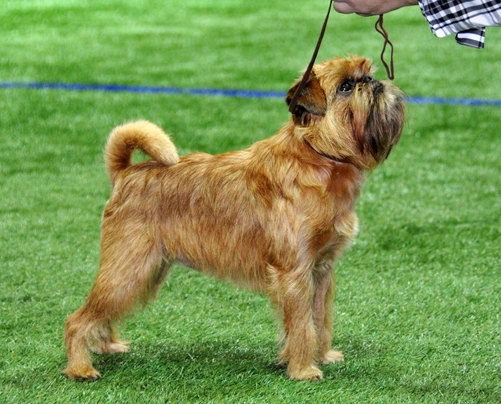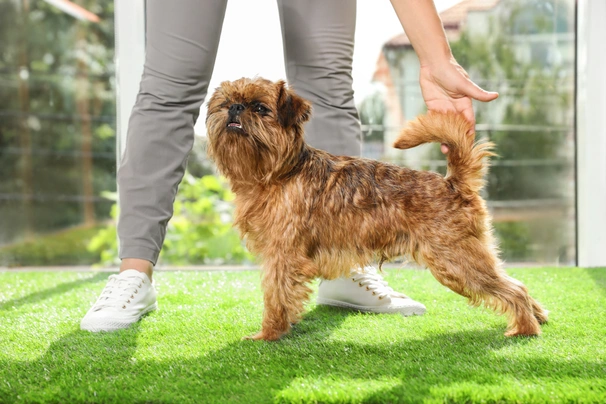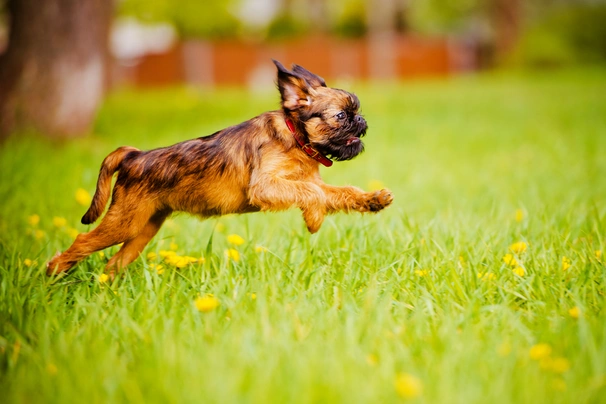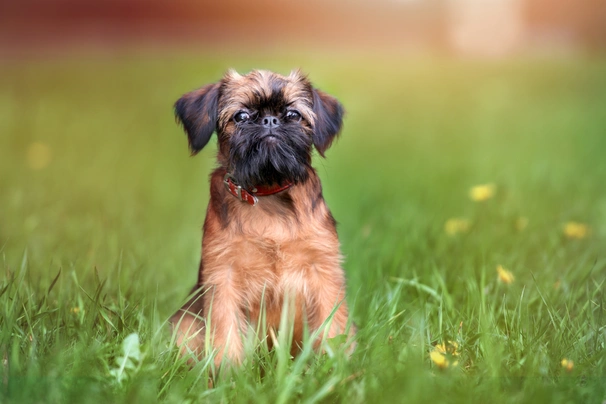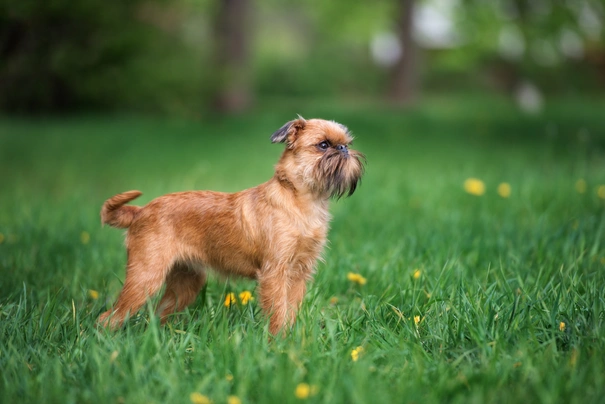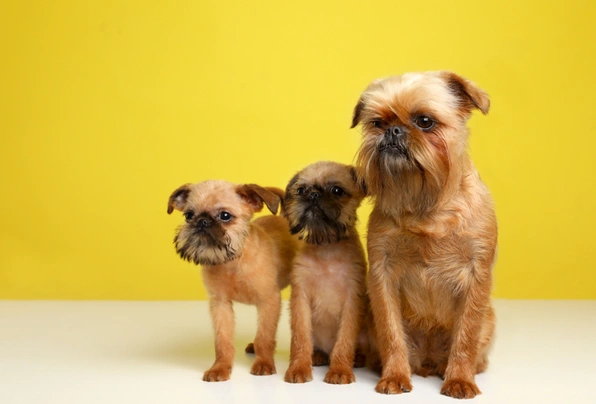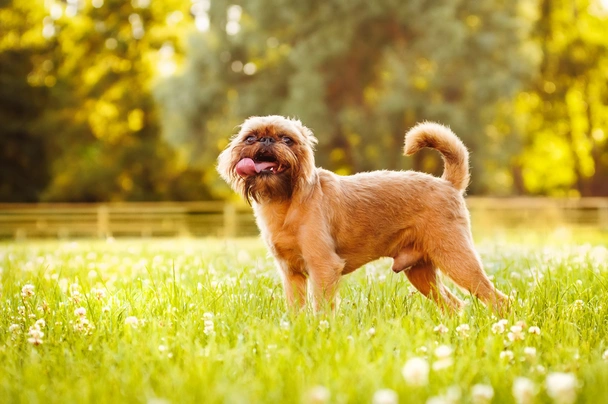Griffon Bruxellois
Pros
Cons
Introduction of the Griffon Bruxellois
A breed that originates from Belgium the Griffon used to be known as the "Belgian street urchin" and just seeing their mischievous faces it's easy to understand why. These little dogs are boast adorable looks with the added bonus of them having fun-loving natures. These are just two of the reasons why Griffons have become such a popular choice as family pets and companions not only here in the UK but elsewhere in the world too.
There are two types of Griffon the first boasting a smooth coat and the second having a rough one. A Griffon with a smooth coat is referred to as Petit Brabançon but both are charming dogs that are great fun to own and to have around with them boasting the same sort of personality too.
History of the Griffon Bruxellois
Originally bred in Belgium the actual origins of the Griffon Bruxellois remains a bit of a mystery but over the years people have come up with various stories of how the breed first came about and how these little dogs were developed. One tale tells us that the breed has been around for centuries citing a painting by the 15th Century master Jan Van Eyck which depicts a very similar dog. Another story tell that the Griffon-type dogs were first seen during the late 1800's and became popular after a dog won third place at the Brussel's Great Dog Show.
With this said similar small dogs were originally bred to be stable dogs keeping the vermin population under control guarding horses and hansom cabs. They were always highly prized for their intelligence stamina and their tenacity. They were known as "Stable E'curie" or "little street urchins" and very often cabbies in the day would let these little dogs ride in their coaches. The breed became very popular with the ladies of the day thanks to their cheeky expressions and affectionate natures.
It is thought that the breed was developed by crossing Pugs Affenpinschers and Belgian stable dogs. As time passed Griffons became highly prized for their toughness and were renowned for combining a "street dog" mentality with the intelligence of an Affenpinscher. The Club du Griffon Bruxellois was established during the 1880's when a breed standard was set out. However as the breed's popularity grew many well-bred dogs were exported out of the country which worried the breed club more especially as a Griffon called Tom won the Brussel's Dog Show and was immediately purchased by an Englishman and taken home to Britain.
When these little dogs arrived in England in the late 1800's they were registered with the Kennel Club as being "Foreign Dogs". By 1898 the breed was finally recognised by the Kennel Club although there were only 3 dogs registered at the time two of which were the first and second Griffon Bruxellois to become British Champions and their names were Bruno and Mousequetaire Rouge. It was a few years later that the KC decided that Griffons with cropped ears could no longer be exhibited which led to more English breeders setting up their own breeding programmes.
The First and Second World Wars had a negative impact on the breed and their numbers fell dangerously low more especially as dogs with "webbed" feet were no longer considered to be good "breeding stock" as the trait was thought of as being a fault that needed to bred out. By 1945 the breed had virtually vanished in their native Belgium but thanks to breeders in the UK who exported a lot of dogs back to the country the Griffon was saved from vanishing altogether.
By the 1920's and 1930's breed numbers grew in the UK but the number of dogs registered with the Kennel Club remained quite low right up until the 1950's when more dogs were bred and registered. Today these little dogs have found their way into the hearts and homes of many people both here in the UK and in many other countries of the world thanks to their lively affectionate natures and their adorable monkey-like mischievous looks although anyone who would like to share their home with a well-bred Griffon might need to register their interest with breeders and go on a waiting list for the pleasure of doing so.
Interesting facts about the breed
- Is the Griffon Bruxellois a vulnerable breed? No they are very popular in the UK although as previously mentioned finding a well-bred puppy can often mean agreeing to go on a waiting list
- Griffons were once known as "street urchins" in their native Belgium
- They were popular with Belgium royals and the nobility
- Because of their short flat faces Griffons are referred to as being a Brach brachycephalic breed with some dogs developing breathing difficulties
- They have always been highly prized for their ratting skills
- Traditionally a Griffon's tail was always docked but since the law banning the procedure came into effect in 2007 tail docking is now illegal with the exception being for some working breeds and if a dog suffers from some sort of health issue that requires their tails to be docked. The procedure must be agreed and authorised before being performed by a qualified vet
Appearance of the Griffon Bruxellois
Height at the withers: Males 18 - 20 cm Females 18 - 20 cm at the withers
Average weight: Males 3.6 - 4.5 kg Females 3.6 - 4.5 kg
The Griffon is an enchanting looking toy dog that boasts terrier-like traits that makes it a joy to share a home with one. They are well-balanced although quite cobby in appearance which adds to their overall appeal. There are two types with the first being rough-coated and the second boasting a smooth coat. Their heads are big in relation to the size of their body with dogs boasting a rounded not domed skull which is quite wide between a dog’s ears.
The hair on a dog’s head is rough but not coarse and they boast black noses with open nostrils and a very well-defined stop. Their muzzle is shortish with dogs boasting tight lips and prominent chin. Rough coated Griffons have beards whereas a smooth coated dog does not.
Eyes are dark in colour clear and round set nicely apart with an alert expression. Their ears are set high and small with dogs carrying them semi-erect. A Griffon’s mouth is slightly undershot but dogs don’t show any teeth or their tongues. Their neck is moderately long and dogs hold them slightly arched with shoulders being well laid back.
Their chest is deep and wide with Griffon’s boasting strong straight front legs with lots of bone. They are compact dogs and therefore have short level backs with well sprung ribs and strong albeit short loins. Hindquarters are muscular with well-muscled thighs and longish back legs. Their feet are very cat-like and small with dogs having black nails. Tails are set high moderately long and at right angles from a dog’s topline which they carry curved over their backs when they are on the move.
When it comes to their coat Griffons with a rough coat have wiry and harsh coats with an undercoat. However smooth coated dogs have shorter and tight coats with no undercoat. Accepted colours include the following:
- Black & Tan Rough
- Black & Tan Smooth
- Black Rough
- Black Smooth
- Red Rough
- Red Smooth
Gait/movement
When a Griffon Bruxellois moves they do so with lots of drive with a free-moving gait without being high stepping whatsoever.
Faults
The Kennel Club frowns on any exaggerations or departures from the breed standard and would judge the faults on how much they affect a dog's overall health and wellbeing as well as their ability to perform.
Males should have both testicles fully descended into their scrotums and it is worth noting that a dog can be a little lighter or heavier as well as slightly taller or shorter than set out in the Kennel Club breed standard which is given as a guideline only.
Temperament of the Griffon Bruxellois
The Griffon Bruxellois is a lively alert little dog that boasts many terrier-like traits which includes the fact they are fun-loving and affectionate characters by nature. They are a great choice for first time owners because these little dogs are very intelligent and in the right hands they are easy to train. They are known to be sensitive and as such they do not respond well to any sort of harsh handling or training but they respond well to positive reinforcement.
Griffon puppies must be well socialised from a young age which means introducing them to as many new situations people and animals as possible once they have been fully vaccinated. They are known to have a bit of a stubborn streak but when they are given the right sort of guidance and direction they can excel at many canine sporting activities.
Griffons form a very strong connection with their owners and as such these little dogs really do not like being left to their own devices for too long. They are prone to suffer from separation anxiety which can result in Griffons developing unwanted and destructive behavioural issues around the home. They are the ideal choice for households where at least one person stays at home when everyone else is out at work. They are not a great choice for people who spend most of the day out of the house leaving their dog on their own.
Are they a good choice for first time owners?
Griffons are the perfect choice for first time dog owners because they are so amenable and people-oriented loving nothing more than to please and to entertain their families. With this said they are better suited to households with older children rather than toddlers.
What about prey drive?
The Griffon Bruxellois has a very high prey drive and will happily turn a deaf ear to a command if they spot something more interesting in the distance and decide to investigate instead. As such care should always be taken as to where and when a Griffon can run off the lead especially when there are wild animals and livestock nearby bearing mind that these little dogs are tenacious and will not give up when they decide to give chase.
What about playfulness?
Griffons have a very playful side to their natures and love to entertain and be entertained. They are known to be a little mischievous when the mood takes them and being so clever a Griffon quickly learns what please an owner and how to get something they want. Being so playful and clever Griffons will constantly test the limits to see how much they can get away with which is a typical "terrier" trait.
What about adaptability?
Griffons are highly adaptable dogs and providing they are given enough daily physical exercise combined with as much mental stimulation to prevent boredom from setting in they are just as happy living in an apartment in town as they would be living in a house in the country.
What about separation anxiety?
Griffons form strong ties with their families and are never that happy when they find themselves left on their own even for shorter periods of time. As such they are better suited to people who either work from home or in households where one person stays at home when everyone else is out so they are never alone for any length of time which could see a dog suffering from separation anxiety. This can lead to them being destructive around the home which is a dog's way of relieving any stress they are feeling and a way to keep themselves entertained which often includes incessant barking.
What about excessive barking?
Griffons are known to like the sound of their own voices a little too much which is something that needs to be gently nipped in the bud when a dog is still young being careful not to frighten them before it turns into a real issue. However some dogs cannot resist barking for the sake of it and will voice an opinion whenever they can.
Do Griffons like water?
Most Griffons like swimming and will take to the water whenever they can more especially when the weather is hot. However if anyone who owns a dog that does not like water should never force them to go in because it would just end up scaring them. With this said care should always be taken when walking a Griffon Bruxellois off the lead anywhere near more dangerous watercourses just in case a dog decides to leap in and then needs rescuing because they cannot get out of the water on their own.
Are Griffons good watchdogs?
The Griffon Bruxellois is a natural watchdog and although only small in stature they are always alert and ready to let their owners know when there are strangers about or when something they don't like is going on around them although they would rarely do this aggressively preferring to keep their distance and bark.
Intelligence / Trainability of the Griffon Bruxellois
Griffons are sensitive dogs and do not respond well to any sort of harsh training or correction. They do answer well to positive reinforcement and when they are given the right sort of guidance and direction these little dogs can be trained to take part in all sorts of canine sports and they do very well at them. Their training must start early because it is important to curb some of their stronger "terrier" traits before things get out of hand.
It is also important for Griffons to be well handled from a young age which means training them to have their paws and ears touched because otherwise a lot of these little dogs get extremely stressed out when it comes to trimming their nails or checking their ears for infections.
Griffon puppies are incredibly cute and they are clever too. In short they are quick to learn new things but this includes the good and the bad. New owners should start out as they mean to go on to avoid a Griffon developing a condition known as Small Dog Syndrome. This can make them unruly and wilful making them harder to handle and live with. It's best to set out the rules limits and boundaries right from the word go so that a Griffon puppy understands what is acceptable behaviour and what is not. The first commands a puppy should be taught are as follows:
- Come
- Sit
- Stay
- Quiet
- Leave it
- Down
- Bed
Children and other
Griffons generally get on with children but any sort of rough handling and play must be avoided which means any interaction between the kids and a dog should be well supervised by an adult to make sure play time stays calm and to prevent things from getting out of hand.
These little dogs are usually good around other dogs and if they have grown up with cats they will tolerate them being around too. If a Griffon has been introduced to smaller pets and animals they will accept being around them but it would be unwise to leave a Griffon alone in a room with them.
Health of the Griffon Bruxellois
The average life expectancy of a Griffon Bruxellois is between 9 and 15 years when properly cared for and fed an appropriate good quality diet to suit their ages.
The Griffon is known to be a robust little dog and one that does not boast suffering from many of the hereditary and congenital health issues that plague a lot of other pedigree dogs. The health concerns that affect the breed the most worth knowing about if you are hoping to share your home with one of these lively energetic little dogs include the following:
- Syringomyelia and Chiari-like Malformation (CMSM) - dogs can be scanned
- Patellar luxation - dogs can be tested and graded by a qualified vet
- Cleft palate
- Degenerative disc disease
- A sensitivity to the Leptospirosis vaccine
- Difficulties birthing due to the size of puppy’s heads
More about head shape for Griffons
Griffons with extremely short muzzles. very flat faces and wide heads can suffer from several health issues which includes them suffering from breathing difficulties and dental problems. As such prospective owners should be aware of these issues when thinking about buying a Griffon Bruxellois with an extra flat face.
What about vaccinations?
Griffon puppies would have been given their initial vaccinations before being sold but it is up to their new owners to make sure they have their follow-up shots in a timely manner with the vaccination schedule for puppies being as follows:
- 10 -12 weeks old bearing in mind that a puppy would not have full protection straight away but would be fully protected 2 weeks after they have had their second vaccination
There has been a lot of discussion about the need for dogs to have boosters. As such it's best to talk to a vet before making a final decision on whether a dog should continue to have annual vaccinations which are known as boosters.
What about spaying and neutering?
A lot of vets these days recommend waiting until dogs are slightly older before spaying and neutering them which means they are more mature before undergoing the procedures. As such they advise neutering males and spaying females when they are between the ages of 6 to 9 months old and sometimes even when a dog is 12 months old.
Other vets recommend spaying and neutering dogs when they are 6 months old but never any earlier unless for medical reasons. With this said many breeds are different and it is always advisable to discuss things with a vet and then follow their advice on when a dog should be spayed or neutered.
What about obesity problems?
Griffons can gain weight after they have been spayed or neutered and it's important to keep an eye on a dog's waistline just in case they do. If a dog starts to put on weight it's important to adjust their daily calorie intake and to up the amount of exercise they are given. Older dogs too are more prone to gaining weight and again it's essential they be fed and exercised accordingly because obesity can shorten a dog's life by several years. The reason being that it puts a lot of extra strain on a dog's internal organs including the heart which could prove fatal.
What about allergies?
Some Griffons are prone to suffering from allergies and it's important for a dog to see a vet sooner rather than later if one flares up. Allergies can be notoriously hard to clear up and finding the triggers can be challenging. With this said a vet would be able to make a dog with an allergy more comfortable while they try to find out the triggers which could include the following:
- Certain dog foods that contain high levels of cereal and other grain fillers
- Airborne pollens
- Dust mites
- Environment
- Flea and tick bites
- Chemicals found in everyday household cleaning products
Participating in health schemes
All responsible Griffon breeders would ensure that their stud dogs are tested for known hereditary and congenital health issues known to affect the breed by using the following schemes:
- The Griffon Bruxellois Breed Club strongly recommends that breeders have dogs scanned for Chiari Like Malformation (CM) and Syringomyelia (SM)
- Under the BVA/KC/ISDS Eye Scheme breeders can have dogs tested for Hereditary cataract (HC) every 3 years
- Patellar luxation - dogs can be tested and graded by a qualified vet
What about breed specific breeding restrictions?
The Griffon Bruxellois has 2 types of coat being the smooth and the rough. Owners and breeders have the option to register smooth coated dogs online or by standard mail with the appropriate accompanying application.
What about Assured Breeder Requirements?
Currently there are no DNA tests or veterinary screening schemes available for the Griffon Bruxellois under the KC/BVA scheme. Prospective owners should however ask breeders about relevant health issues that are known to affect the breed.
Caring for the Griffon Bruxellois
As with any other breed Griffons need to be groomed on a regular basis to make sure their coats and skin are kept in top condition. They also need to be given regular daily exercise to ensure they remain fit and healthy. On top of this they need to be fed good quality food that meets all their nutritional needs throughout their lives.
Caringfor a Griffon Bruxellois puppy
Griffon puppies are boisterous and full of life which means it's essential for homes and gardens to be puppy-proofed well in advance of their arrival. A responsible breeder would have well socialised their puppies which always leads to more outgoing confident and friendly dogs right from the word go. With this said any puppy is going to feel vulnerable when they leave their mother and littermates which must be taken into account. The longer a puppy can remain with their mother the better although it should never be for too long either.
It's best to pick a puppy up when people are going to be around for the first week or so which is the time needed for a puppy to settle in. Puppy-proofing the home and garden means putting away any tools and other implements that a boisterous puppy might injure themselves on. Electric wires and cables must be put out of their reach because puppies love chewing on things. Toxic plants should be removed from flowerbeds and the home too.
Puppies need to sleep a lot to grow and develop as they should which means setting up a quiet area that's not too out of the way means they can retreat to it when they want to nap and it's important not to disturb them when they are sleeping. It's also a good idea to keep "playtime" nice and calm inside the house and to have a more active "playtime" outside in the garden which means puppies quickly learn to be less boisterous when they are inside.
The documentation a breeder provides for a puppy must have all the details of their worming date and the product used as well as the information relating to their microchip. It is essential for puppies to be wormed again keeping to a schedule which is as follows:
- Puppies should be wormed at 6 months old
- They need to be wormed again when they are 8 months old
- Puppies should be wormed when they are 10 months old
- They need to be wormed when they are 12 months old
Things you'll need for your puppy
There are certain items that new owners need to already have in the home prior to bringing a new puppy home. It's often a good idea to restrict how much space a puppy plays in more especially when you can't keep an eye on what they get up to bearing in mind that puppies are often quite boisterous which means investing in puppy gates or a large enough playpen that allows a puppy the room to express themselves while keeping them safe too. The items needed are therefore as follows:
- Good quality puppy or baby gates to fit on doors
- A good well-made playpen that's large enough for a puppy to play in so they can really express themselves as puppies like to do
- Lots of well-made toys which must include good quality chews suitable for puppies to gnaw on bearing in mind that a puppy will start teething anything from when they are 3 to 8 months old
- Good quality feed and water bowls which ideally should be ceramic rather than plastic or metal
- A grooming glove
- A slicker brush or soft bristle brush
- Dog specific toothpaste and a toothbrush
- Scissors with rounded ends
- Nail clippers
- Puppy shampoo and conditioner which must be specifically formulated for use on dogs
- A well-made dog collar or harness
- A couple of strong dog leads
- A well-made dog bed that's not too small or too big
- A well-made dog crate for use in the car and in the home that's large enough for a puppy to move around in
- Baby blankets to put in your puppy's crate and in their beds for when they want to nap or go to sleep at night
Keeping the noise down
All puppies are sensitive to noise including Griffon puppies. It's important to keep the noise levels down when a new puppy arrives in the home. TVs and music should not be played too loud which could end up stressing a small puppy out.
Keeping vet appointments
As previously mentioned Griffon puppies would have been given their first vaccinations by the breeders but they must have their follow up shots which is up to their new owners to organise. The vaccination schedule for puppies is as follows:
- 10 -12 weeks old bearing in mind that a puppy would not have full protection straight away but would only be fully protected 2 weeks after they have had their second vaccination
When it comes to boosters it's best to discuss these with a vet because there is a lot of debate about whether a dog really needs them after a certain time. However if a dog ever needed to go into kennels their vaccinations would need to be fully up to date.
What about older Griffon Bruxellois when they reach their senior years?
Older Griffons need lots of special care because as they reach their golden years they are more at risk of developing certain health concerns. Physically a dog's muzzle may start to go grey but there will be other noticeable changes too which includes the following:
- Coats become coarser
- A loss of muscle tone
- Griffons can either become overweight or underweight
- They have reduced strength and stamina
- Older dogs have difficulty regulating their body temperature
- They often develop arthritis
- Immune systems do not work as efficiently as they once did which means dogs are more susceptible to infections
Older dogs change mentally too which means their response time tends to be slower as such they develop the following:
- They respond less to external stimuli due to impaired vision or hearing
- They tend to be a little pickier about their food
- They have a lower pain threshold
- Become intolerant of any change
- Often an older dog can feel disorientated
Living with a Griffon Bruxellois in their golden years means taking on a few more responsibilities but these are easily managed and should include taking a look at their diet the amount of exercise they are given how often their dog beds need changing and keeping an eye on the condition of their teeth.
Older Griffons need to be fed a good quality diet that meets their needs at this stage of their lives all the while keeping a close eye on a dog's weight. A rough feeding guide for older dogs is as follows bearing in mind they should be fed highly digestible food that does not contain any additives:
- Protein content should be anything from 14 – 21%
- Fat content should be less than 10%
- Fibre content should be less than 4%
- Calcium content should be 0.5 – 0.8%
- Phosphorous content should be 0.4 – 0.7%
- Sodium content should be 0.2 – 0.4%
Older Griffons don't need to be given the same amount of daily exercise as a younger dog but they still need the right amount of physical activity to maintain muscle tone and to prevent a dog from putting on too much weight. All dogs need access to fresh clean water and this is especially true of older dogs when they reach their golden years because they are more at risk of developing kidney disorders.
Grooming of the Griffon Bruxellois
Griffons with short coats are low maintenance on the grooming front and just a weekly brush will keep things tidy and looking good. However a rough coated Griffon is higher maintenance because their coats need to be hand stripped at least twice a year and ideally this needs to be left to a professional groomer. It's also important to keep an eye on a Griffon's ears and to clean them when necessary to prevent the risk of any infections taking hold which are known to be notoriously hard to clear up.
It's also important to comb and clean a Griffon's face every day because food often gets stuck in the folds which if left starts to smell and could lead to a dog developing painful sores which are often hard to clear up.
Exercise of the Griffon Bruxellois
Griffons are energetic little dogs and they need to be given at least 30 to 60 minutes exercise every day. With this said they are a good choice for people who lead more sedentary lives and who would take their dogs out for several short walks a day. Ideally Griffons should be taken for a shorter walk first thing in the morning and then a longer more interesting one in the afternoon. They also enjoy being able to romp around in a back garden as often as possible where they can really let off steam but the fencing must be very secure to keep these dogs in.
It's also important for Griffons to be given lots of mental stimulation because otherwise these intelligent little dogs might get bored and as a result they will find ways to entertain and amuse themselves which could mean them being a little destructive around the home.
Feeding of the Griffon Bruxellois
If you get a Griffon Bruxellois puppy from a breeder they would give you a feeding schedule and it's important to stick to the same routine feeding the same puppy food to avoid any tummy upsets. You can change a puppy's diet but this needs to be done very gradually always making sure they don't develop any digestive upsets and if they do it's best to put them back on their original diet and to discuss things with the vet before attempting to change it again.
Older dogs are not known to be fussy or finicky eaters but this does not mean you can feed them a lower quality diet. It's best to feed a mature dog twice a day once in the morning and then again in the evening making sure it's good quality food that meets all their nutritional requirements. It's also important that dogs be given the right amount of exercise so they burn off any excess calories or they might gain too much weight which can lead to all sorts of health issues. Obesity can shorten a dog's life by several years so it's important to keep an eye on their waistline from the word go.
Feeding guide for a Griffon Bruxellois puppy
Puppies need to be fed a highly nutritious good quality diet for them to develop and grow as they should. As a rough guide a Griffon puppy can be fed the following amounts every day making sure their meals are evenly spread out throughout the day and it's best to feed them 3 or 4 times a day:
- 2 months old - 68g to 78g depending on puppy's build
- 3 months old - 74g to 84g depending on puppy's build
- 4 months old - 75g to 95g depending on puppy's build
- 5 months old - 75g to 95g depending on puppy's build
- 6 months old - 67g to 77g depending on puppy's build
- 7 months old - 60g to 70g depending on puppy's build
- 8 months old - 59g to 69g depending on puppy's build
- 9 months old - 59g to 69g depending on puppy's build
- 10 months old - 59g to 59g depending on puppy's build
Once a puppy is 11 months old they can be fed adult dog food.
Feeding guide for an adult Griffon Bruxellois
Once fully mature an adult Griffon must be fed a good quality diet to ensure their continued good health. As a rough guide an adult Griffon Bruxellois can be fed the following amounts every day:
- Dogs weighing 3.6 kg can be fed 65g to 73g depending on activity
- Dogs weighing 4.5 kg can be fed 78g to 89g depending on activity
Griffon Bruxellois price
If you are looking to buy a Griffon Bruxellois you would need to pay anything from £500 to over £1200 for a well-bred pedigree puppy. The cost of insuring a male 3-year-old Griffon in northern England would be £21.65 a month for basic cover but for a lifetime policy this would set you back £43.61 a month (quote as of February 2018). When insurance companies calculate a pet's premium they factor in several things which includes where you live in the UK and a dog's age and whether they have been neutered or spayed.
When it comes to food costs you need to buy the best quality food whether wet or dry to feed your dog throughout their lives making sure it suits the different stages of their lives. This would set you back between £40 - £50 a month. On top of this you would need to factor in veterinary costs if you want to share your home with a Griffon and this includes their initial vaccinations their annual boosters the cost of neutering or spaying your dog when the time is right and then their yearly health checks all of which quickly adds up to over a £800 a year.
As a rough guide the average cost to keep and care for a Griffon Bruxellois would be between £70 to £100 a month depending on the level of insurance cover you opt to buy for your dog but this does not include the initial cost of buying a healthy well-bred Kennel Club registered pedigree Griffon puppy.
Buying advice
When visiting and buying any puppy or dog there are many important things to consider and questions to ask of the breeder/seller. You can read our generic puppy/dog advice here which includes making sure you see the puppy with its mother and to verify that the dog has been wormed and microchipped.
Griffons are among some of the more popular breeds both in the UK and elsewhere in the world which means that well-bred puppies command a lot of money. As such with the Griffon Bruxellois there is specific advice questions and protocols to follow when buying a puppy which are as follows:
- Beware of online scams and how to avoid them. You may see online and other adverts by scammers showing images of beautiful Griffonpuppies for sale at very low prices. However the sellers ask buyers for money up front before agreeing to deliver a puppy to a new home. Potential buyers should never buy a puppy unseen and should never pay a deposit or any other money online to a seller. You should always visit the pet at the sellers home to confirm they are genuine and make a note of their address.
- As previously touched upon Griffon Bruxellois are among some of the more popular breeds in the UK. As such there are many amateur breeders/people who breed from a dam far too often so they can make a quick profit without caring for the welfare of the puppies their dam or the breed in general. Under Kennel Club rules a dam can only produce 4 litters and she must be between a certain age to do so. Anyone wishing to buy a Griffon Bruxellois puppy should think very carefully about who they purchase their puppy from and should always ask to see the relevant paperwork pertaining to a puppy's lineage their vaccinations and their microchipping.
- Prospective owners should be very careful when considering buying an extra small Griffon puppy because all too often they suffer from very serious health issues and no responsible breeder would purposefully breed dogs so they are too small.
- Griffons with very flat faces often suffer from breathing issues so it is important that prospective owners avoid purchasing puppies with very exaggerated facial structures.
